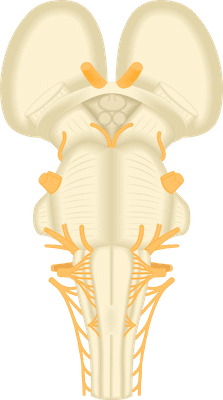Serena Yue
Hong Kong, China
Dear brainstem,
You remind me of the Mona Lisa, seated firmly and comfortably atop the spinal cord. The Mona Lisa exudes royalty and class, from her posture and garments to the plump smoothness of her hands. Your elegance also enthralls me, from the sleek medulla oblongata, ascending to the pons with all its irresistible grooves and bumps. From the pyramids along the anterior medulla, to the posterior nucleus gracilis and nucleus cuneatus, you are like the fluted shafts of a Greek temple’s columns (Figure 1). In the midbrain, the colliculi appear like breasts, and the cranial nerves emerge from you like gently cascading strands of hair.
The Mona Lisa is encased in bulletproof, waterproof glass. The painting is well protected after episodes of vandalism that have included stones and spray paint. The reasons for these outbursts vary, but have included a man declaring his unrequited love and a woman unleashing her rage for the museum’s limited access for people with disabilities. Brainstem, you may have been the recipient of frustrated students’ venting as well, struggling in their attempts to understand you. But you do not know this, as you maintain wakefulness, but not consciousness.
The Mona Lisa appears “alive” because of da Vinci’s pioneering technique of sfumato, blurring outlines so that the portrait appears to both blend into and emerge from the background. While you, brainstem, are entirely static, I nonetheless feel alive when I contemplate your complexity. Like the Mona Lisa, you remain a mystery. Even after studying neuroanatomy textbooks, lecture notes, and stained cross sections in the dissection lab, I still barely know you.
When I was at the Louvre Museum in 2020, I visited the Mona Lisa. It would have been a climatic experience if not for the long, winding line of people (Figure 2), all hastily whipping out their phones to snap an obligatory selfie. I was permitted only thirty seconds with the painting before being ushered away by the museum staff. Thirty seconds is about the same amount of time we are given to identify your structures during an exam. When I arrive at your station in the dissection lab, I almost feel an urge to snap a selfie.
Historians have studied not only Mona Lisa’s portrait, but the sprawling landscape of wilderness behind her. Da Vinci used an aerial perspective to depict the landscape, adding depth and dimension to the painting. Medical students have a charismatic and complex anatomical structure to study that sits snugly behind the brainstem: the cerebellum. Another fascinating focus of the background of the Mona Lisa are the distinctive arches of aqueducts (Figures 3 and 4). There is also an aqueduct behind the brainstem, the Sylvian aqueduct, which connects the third and fourth ventricles.
Leonardo da Vinci is hailed as one of the masters of the Italian High Renaissance. The defining theme of this time was the study of the humanities, and artists strived to achieve new heights of beauty and idealism. It was a glorious affirmation of human potential. Brainstem, I hope studying you will help me to reach my own full potential, during my medical studies and beyond.




The Mona Lisa. Leonardo da Vinci, between 1503 and 1506. Louvre Museum. Via Wikimedia. Public domain.

Brainstem, ventral view. Designed by erico and edited by 小野 浩雅(ONO, Hiromasa). © 2016 DBCLS TogoTV. CC-BY-4.0.

SERENA YUE’s background in biochemistry and epidemiology gave her a solid footing at both ends of the spectrum of medicine; from molecular biology to epidemiology. She continues to draw on this knowledge as she pursues a career as a future doctor. Currently, Serena is a medical student, with a particular interest in non-communicable diseases such as cancer and diabetes. She can be found on LinkedIn.

Leave a Reply